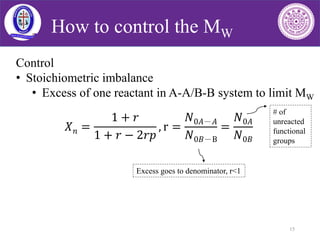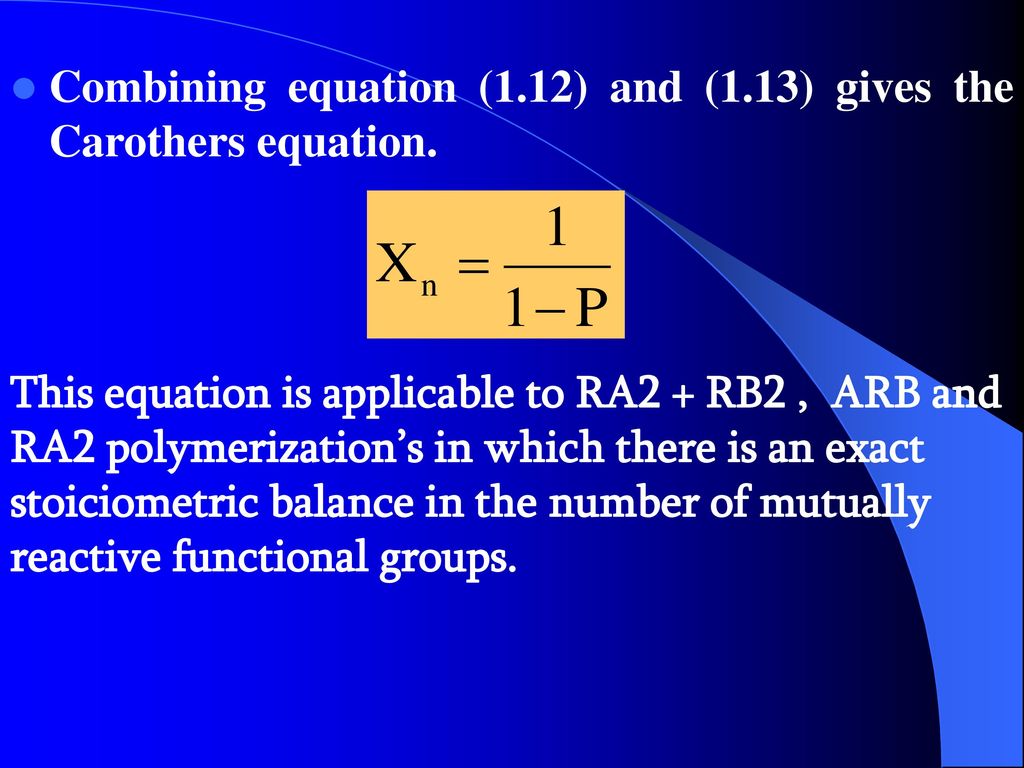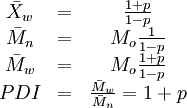carothers equation polymer
After integration and substitution from Carothers equation the final form is the following Carothers. N 0 is the number of molecules present initially N is the number of unreacted molecules at time t p is also a measure of the extent of reaction or yield.

3 2 Kinetics Of Step Growth Polymerization Chemistry Libretexts
In this classification.

. New one-pot Approaches to Hyperbranced Species. In step-growth polymerization the Carothers equation or Carothers equation gives the degree of polymerization X n for a given fractional monomer conversion p. The American Chemical Society designated Wallace Carothers contributions to modern polymer science and the development of nylon as National Historic Chemical Landmarks in ceremonies on October 26 1995 at the DuPont nylon plant now operated by Invista in Seaford Delaware and on November 17 2000 at the DuPont.
21 gives X n A A o A A 27a or AA AA o X n. Pn Approach 8 Network Formation. For the example of nylon-66 X n 2n n diamine units and n diacid units.
The Carothers equation is often used to predict the utility of a small molecule reaction in a polymerization. This equation was proposed by Wallace Carothers who invented nylon in 1935. A number of butyl branches on the polymer main chain these butyl branches are generated by a back-biting.
The simplest case refers to the formation of a strictly linear polymer. Derivation of the Carothers equation for molecular mass as a function of the extent of the reaction p and reactant ratio r. Two monomers in equimolar quantities.
The theory was initially conceptualized by Paul Flory in 1941 and then was further developed by Walter. The work of Carothers at Du Pont in the period 1929 to 1938 produced a whole range of industrially important polymers via the condensation route. In step-growth polymerization in order to achieve a high degree of polymerization and hence molecular weight X n a high fractional monomer conversion p is required according to Carothers equation For example a monomer conversion of p 99 would be required to achieve X n 100.
P N 0-NN 0 where. It is uncovered that the second chain extension cross-coupling proceeds much more efficiently than the first cross-coupling and the homocoupling side reaction at least 1 order of. He was the oldest of four children.
The polyamide family of the nylons was quickly identified and by the middle of the decade the potential of one particular member nylon 66 5 as a fibre-forming polymer was recognizedA variety of polyesters were also examined and these were. 26 for 1 p and subsequent substitution into the Carothers equation eq. The total includes all degrees of.
N In step-growth polymerization the Carothers Equation Carothers Equation gives the degree of polymerization Xn for a given fractional monomer conversion p Odain 2004. The Flory-Stockmayer theory represents an advancement from the Carothers equation allowing for the identification of the gel point for polymer synthesis not at stoichiometric balance. For the case of linear polymers - two monomers in equimolar quantities.
There are several versions of this equation proposed by Wallace Carothers who invented nylon in 1935. X n is the number-average value of the degree of polymerization equal to the average number of monomer units in a polymer molecule. A high monomer conversion is required to achieve a high number-average.
P N 0-NN 0 where. The Carothers Equation High Molecular weights are hard to get this way If there are N o molecules at time 0 and N remaining at time t then the amount reacted is N 0. In this study we present the mechanistic study of PdAg cocatalyzed cross dehydrogenative coupling CDC polymerization to synthesize a donoracceptor DA polymer of 33-dihexyl-22-bithiophene and 22335566-octafluorobiphenyl which go counter to the.
A Word on MWD for Nonlinear Polymerizations 9 Step-by-Step Approaches I. Donoracceptor DA polymer of 33-dihexyl-22-bithiophene and 22335566-octafluorobiphenyl which go counter to the Carothers equation. This equation is based on general stochastic insights and gives the degree of polymerization or number average chain length i.
Is the number of molecules present after time t. In step-growth polymerization the Carothers equation or Carothers equation gives the degree of polymerization Xn for a given fractional monomer conversion. Carothers equation is used to illustrate the extent of reaction for linear polycondensation or polyaddition polymerization reactions.
Polymer Synthesis A s discussed in Chapter 1 a useful classifica-tion of all polymers is based upon the kinetics of the polymerization. P is the extent of reaction or conversion to polymer defined by. The simplest case refers to the formation of a strictly linear polymer by the reaction usually by condensation of.
Step-growth polymerization vs chain growth to be covered in more detail later in the course extent of reaction number-average degree of polymerization. Dendrimers Traditional Convergent and Divergent Routes. If X n describes the number of average chain length and P describes the extent of the reaction then starting with N 0 as the number of molecules at the beginning of the polymerization after some time has.
Was born on November 27 1937Carothers was born on April 27 1896 in Burlington Iowa to Ira and Mary Evalina Carothers. FloryStockmayer theory is a theory governing the cross-linking and gelation of step-growth polymers. N 0 is the number of.
Two monomers in equimolar quantities. X n is also the average chain length in monomer units. A challenge in the field of polymer network synthesis by a step-growth mechanism is the quantification of the relative importance of inter- vs.
Or conversion to polymer defined by. In step-growth polymerization the Carothers equation or Carothers equation gives the degree of polymerization X n. Up to 10 cash back Carothers Equation.
In the case of non-stoichiometric ratios of two or more different functional groups Florys and Stockmayers statistical approaches give more accurate results. Later denoted as the Carothers equation. The simplest case refers to the formation of a strictly linear polymer by.
Carothers equation is applicable only to stoichiometric mixtures of addition monomers or if only one type of functional group undergoes polymerization as it is the case with chain growth. There are several versions of this equation proposed by Wallace Carothers who invented nylon in 1935. Is the number of molecules present initially as monomer.

Degree Of Polymerization Of Polymers Materials Today

Spring 2007 Chap 8 Polycondensation Reactions Classification By

Dodt Oxidative Polymerization Data Dashed Line Plotted Against The Download Scientific Diagram

Macromolecular Chemistry Lecture 5 Step Growth Chain Growth

Chapter 9 Kinetics Of Chain And Step Growth Polymerization

An Exception To The Carothers Equation Caused By The Accelerated Chain Extension In A Pd Ag Cocatalyzed Cross Dehydrogenative Coupling Polymerization Journal Of The American Chemical Society

Lecture 2 The Carothers Equation Youtube

Carothers Theory L Carothers Developed A Simple Method

3 2 Kinetics Of Step Growth Polymerization Chemistry Libretexts

Introduction To Polymers Lecture 5 5 Step Growth Molecular Weight Part 2 Youtube

Step Growth Polymerization The Carothers Equation And The Flory Schulz Distribution Montoguequiz Com

Degree Of Polymerization Of Polymers Materials Today

Spring 2007 Chap 8 Polycondensation Reactions Classification By

Spring 2007 Chap 8 Polycondensation Reactions Classification By

Carothers Theory Carothers Developed A Simple Method Of Analysis For Predicting The Molar Mass Of Polymer Prepared By Step Polymerization He Recognized Ppt Download

Carothers Theory Carothers Developed A Simple Method Of Analysis For Predicting The Molar Mass Of Polymer Prepared By Step Polymerization He Recognized Ppt Download


Comments
Post a Comment